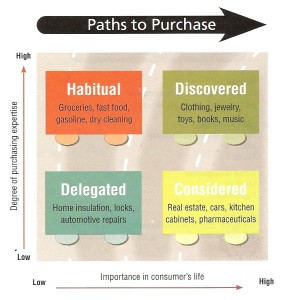Various studies report that only about 4-7% of B2B buyers are in the buying mode for a particular product or service at any given time. Other studies report that anywhere from 55-70% of a B2B buyer’s purchasing journey is done anonymously – activities of which sellers aren’t aware. While these stats vary based on a variety of issues and conditions, they are indicative of the typical B2B purchase journey. If B2B buyers aren’t always in the buying mode and so much of the buyer’s journey is done without us sellers even knowing what’s going on, how can B2B sales professionals operate in order to seize sales opportunities?
This article provides 4 important steps that will position a B2B sales professional to capitalize on sales opportunities. These steps are 1) understand your target customer, 2) provide opportunities for your target customers to interact with you, 3) nurture relationships with your target customers, and 4) be ready to engage when the right time presents itself.
Step 1 – Understand your target customer
Your target customer behaves in certain predictable ways depending on what you sell. We refer to this as the “path to  purchase” or also referred to as the “buying funnel”. The image to the right provides a way to think about various buyers based on two criteria;
purchase” or also referred to as the “buying funnel”. The image to the right provides a way to think about various buyers based on two criteria;
- Degree of required purchasing expertise and
- Degree of importance to the buyer’s life.
Most B2B buying decisions fall into the “Considered” section. These buyers usually don’t know much about the details of the product/service and their buying decision has risk. These kinds of purchases are infrequent and there is a great deal of anonymous research. Sellers should provide helpful information that’s easily accessible and then nurture buyers through their purchasing journey.
Step 2 – Provide opportunities to interact with you
As mentioned earlier, a large portion of the B2B buying process is done anonymously – online research and inquiring within the buyer’s personal network of contacts. Whether the buyer begins the purchasing journey online or inquires in his network, it is likely the buyer will ultimately go online to gather info. Understanding your target buyer, what is important to him and what problems he is trying to solve are critical pieces of knowledge you must have in order to stand out when this anonymous research is done.
Once the buyer makes his way to your website, are you offering information that helps him through his purchasing journey and are you offering opportunities for him to interact with you? Your website should contain multiple ways for your buyer to interact. These could be videos, articles, whitepapers and case studies that provide helpful information. It could also include offering pricing information, ability to get an online quote, request for a free analysis, or the ability to request contact. These are all opportunities to obtain contact information about the potential buyer. It is doubtful though that anyone will give you their contact information online unless you are giving information that is of great value. This is where most companies fail – the information they are offering just isn’t compelling enough for people to identify themselves through the typical anonymous purchasing journey.
Step 3 – Nurture your leads through the purchasing journey
Once you’ve identified a lead that appears to be qualified, “walk with them” through the purchasing journey – lead nurturing. Additionally, you may have captured qualified buyers in other ways like trade shows, networking and other marketing tactics. Include them in your lead nurturing activities as well.
Remembering that a small percentage of your potential buyers are in the buying mode at any given time, while others are active in their purchasing journey (doing research, evaluating suppliers, etc.), elite salespeople are skilled at this lead nurturing process.
To succeed in lead nurturing, arm yourself with resources that are valuable and helpful to your target buyer. Things like research reports, case studies, helpful articles, informational videos and other forms of compelling content are the kinds of resources you need to stay in contact with your prospects and help them progress through their purchasing journey. Set up a schedule to contact them by sending them some of these helpful resources. There are a variety of CRMs and marketing automation tools out there that make this process efficient to execute.
By staying in contact with your buyers and providing them information that is meaningful and helpful to them, when the buyer gets to the point in his purchasing journey to engage in conversation about the products/services you sell, you will likely be one of the suppliers to which they reach out.
Step 4 – Be accessible when the inquiry is made
You’ve heard the saying “hurry up and wait”. Well there’s truth to that in the B2B selling world. You might be doing a great job of lead nurturing but your buyer just isn’t ready to make a decision – be patient. Buyers don’t want to be sold, they want to buy – you’re on their timetable. When they do finally decide it’s time to make a decision, don’t make them wait. Be appreciative of their interest and be accessible to meet with them.
In summary, realize much of the B2B purchasing journey is done anonymous to you and that only a small portion of your potential buyers are in the buying mode at any given time. To succeed in B2B sales you must have a good understanding of your customer, make it easy for him to interact with you during the purchasing journey, nurture your leads by providing helpful information, and be accessible when your buyer is ready to engage.





Agree, disagree, or just have something to add?
Leave a comment below.